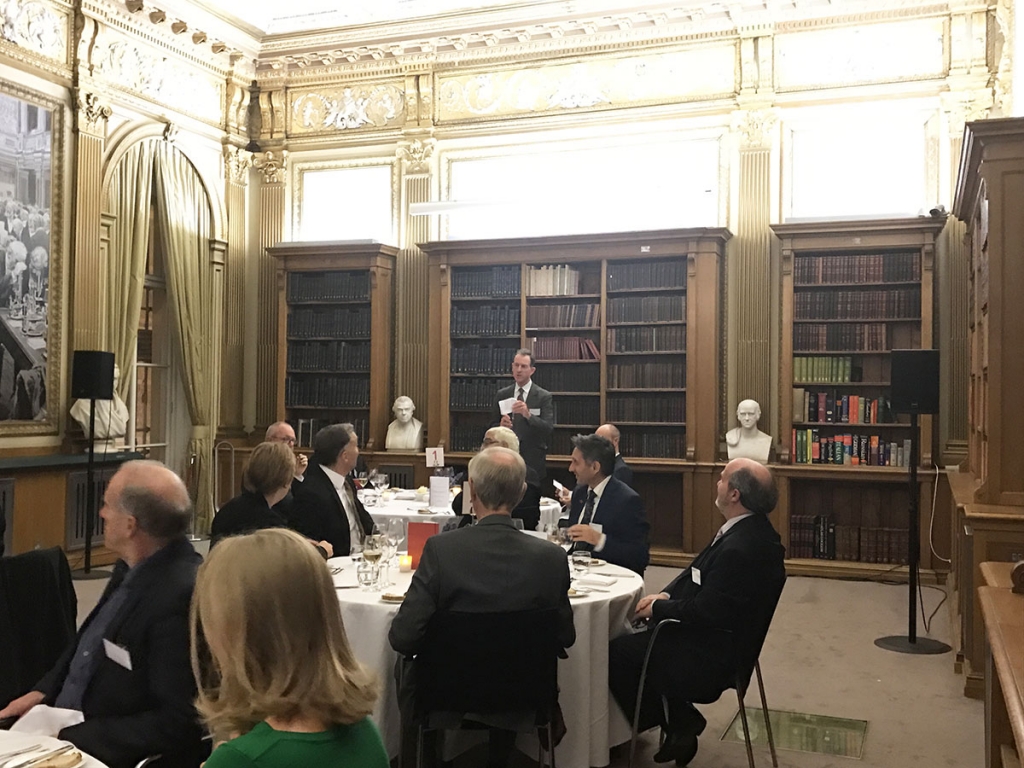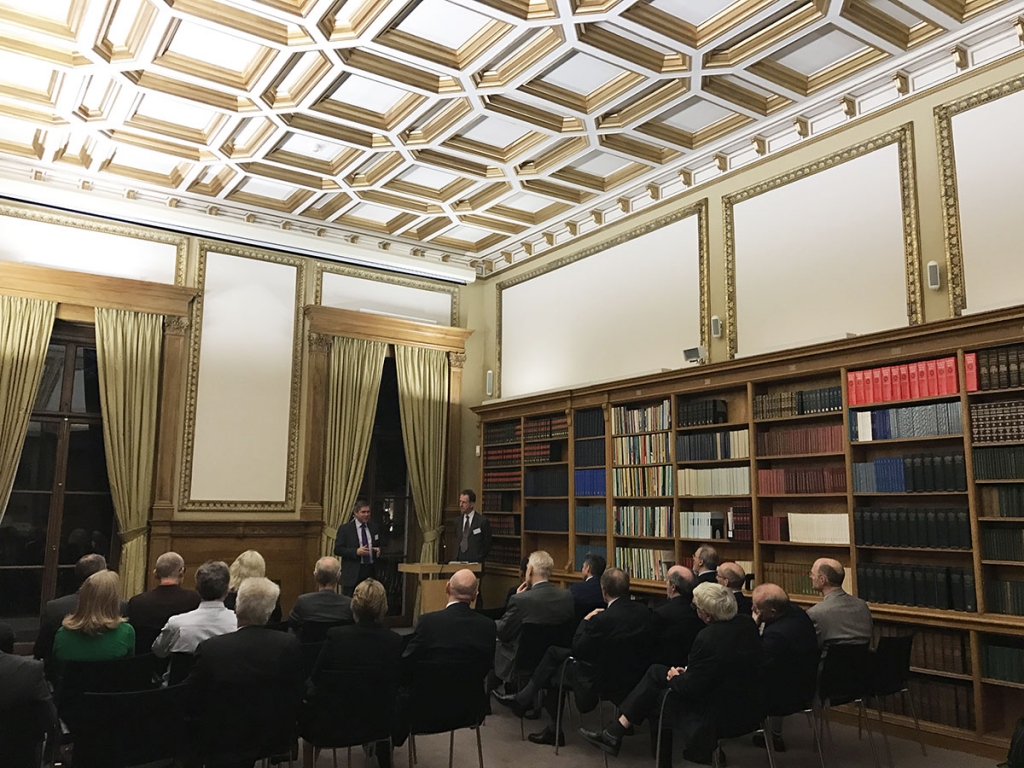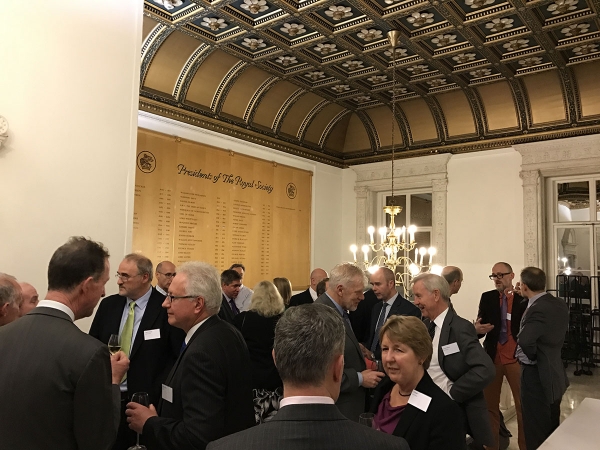Nov. 15th 2016
HONOURED GUESTS
The evening started with selected members and guests giving a brief introduction to their concerns and interests: and highlighted the great depth of experience in the room.
Honoured guests included: Sir Peter Williams, ex-CEO of Oxford Instruments, Chair of the National Physical Laboratory, and former treasurer of the Royal Society; and Prof Derek Fray of Cambridge University, the co-inventor of the ‘FFC Cambridge Process’ for the manufacture of aluminium and other alloys using a fraction of the energy required by conventional methods (therefore a true successor to Sir Henry Bessemer!),
Prof Paul O’Brien FRS, formerly head of Chemistry and Materials at the University of Manchester, gave an introduction to the Royal Society, which is the oldest scientific body meeting continuously in the world. Prof O’Brien is a strong supporter of our Society in the Manchester region, where he is the co-founder of one of the University’s largest spinout companies, Nanoco Technologies, and involved in spinning out others.

Alex Stewart giving a report of the year’s activity
SIR HENRY BESSEMER – A FRESH INSIGHT
The Bessemer Society is not an appreciation or historical society, as the name may suggest, so it could have been misconstrued to invite as our principal speaker, Dr Chris Elliot of Tata Steel Europe, to talk about the life of Sir Henry Bessemer. We did so because Dr Elliot, as Head of New Product Development at Tata Steel (formerly British Steel/Corus) applies inspiration from Bessemer’s example to his role as an innovation leader.
He gave an extremely insightful talk into Sir Henry work as a ‘serial disrupter and life-long learner’. He noted that Bessemer was a prolific inventor – and the steel making invention was only his most important achievement. He made clear too how Bessemer’s tenacity and business acumen were essential in his ultimate success as a steel entrepreneur.
MAN OF STEEL (the caption to Spy’s cartoon of Sir Henry)
As so often in Bessemer’s work, his invention of the steel making process was prompted by the need to solve another problem. He had designed a projectile that could be fired much more accurately, but the additional force it exerted required the cannon to be made of steel rather than iron – and steel was very expensive.
After much experimentation, Bessemer developed a way to manufacture steel in a fraction of the time required by the traditional puddling techniques. However, when his initial licensees, who had paid the considerable license sum of £30,000, couldn’t reproduce the steel by his process, he was forced to refund them their money and return to his workshop to understand why his process was not working.
After further experimentation, he discovered the process varied according to the type of iron ore used. Having solved this problem, the next problem confronting him was that prospective licensees no longer trusted him. To resolve this, he boldly established his own large steel works in the heart of the Sheffield steel industry – which at that time accounted for half the steel manufactured in Europe (mostly for cutlery) – where he was able to manufacture steel at £6 a tonne against the local industry’s £40. Soon all the steel and iron makers had to take a license, in the UK, the Continent, and the USA. A dozen years later he sold his steel mill for a very great profit as well.
LESSONS FOR TODAY
Like any entrepreneur Bessemer learnt some of his most important lessons from bitter experience. Not yet 20 years old, for example, he developed a solution which would save the Stamp Office a fortune in lost revenue caused by the fact it was easy to peel off and re-use stamps on title deed documents. The solution he proposed was so ingenious that the Stamp Office adopted it immediately, then ‘forgot’ to recognize his contribution. The memory rankled with him, until, in his 66th year, he was able to extract from the government a full-page apology in the Times, and in the same year a knighthood, while the Royal Society made him a Fellow!
The experience taught him the importance of patenting, but one process he didn’t patent was a method for manufacturing bronze powder. His artist sister-in-law had told him how much ‘gold’ powder used in picture framing cost. He traced back the supply source to Nuremberg in Germany, which had established a monopoly using techniques for filing bronze by hand.
Bessemer developed a method for automating the process allowing him to manufacture the powder for as little as 6d a kilo when the powder was selling for £11. This was going to be such an incredible money maker that to preserve secrecy he contracted out the manufacture of the different parts of the process to engineering companies far from each other, in Glasgow, Manchester and London, then assembled the parts with the help of his three brothers-in-law. Thereafter the four of them were the only people ever allowed entry to the heavily sealed workshop (at the back of St Pancras Station) for the next 35 years until they ceased operation. Bronze, therefore, rather than steel was the ultimate source of his wealth!

Depth of experience in the room
DISCUSSION
In the lively discussion that followed, the subject of risk taking, learning from mistakes, and the entrepreneurial spirit of innovation were highlighted with illustrations from real-life experience – not text books.
To conclude, Michael LeGoff, Chair of the Society’s Founding Council, noted that Bessemer’s genius lay in identifying a problem and then solving it; he pointed out that the next step is to identify the market need and then to meet it – citing the genius of Steve Jobs. The Bessemer Society’s ‘genius’ he added is the combined experience and insights of its members which accelerates each person’s learning process.

Dr Chris Elliot, Tata Steel Europe
Chris Elliot of Tata Steel wrote about the meeting in an email after:
Personally, I found the atmosphere convivial, the surroundings inspiring, and the conversations (and food!) to be of the highest quality. You have certainly assembled a remarkable constellation of individuals. If possible, I would like to keep in touch with the Society as it develops & hopefully prospers.
ONWARD EVER
Sir Henry Bessemer’s motto was: ‘Onward Ever’ which he had incorporated into his Coat of Arms. We might say today, ‘Never Give Up’… which would be an equally good motto for a Society consisting of entrepreneurs and innovators who may call themselves, ‘Bessemer’s heirs’.









